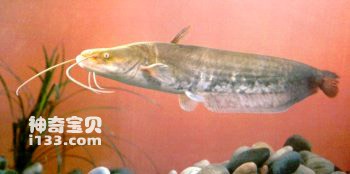Catfish (Silurus spp) belongs to the order Silurus, family Silurus, and genus Silurus. Commonly known as: Catfish, Catfish Balang. Mud fish. English name: Oriental sheatfish, Far east asian catfish.
The body is long, the head is flat, and the back and sides of the head are flat. The mouth is wide, upward, and the lower jaw is prominent. There are many villous fine teeth on the upper and lower jaws and vomer. Adult fish have 2 pairs of barbels and juvenile fish have 3 pairs of barbels. The eyes are small and the body is smooth and scaleless. The dorsal fin is shrunken and clustered; the pectoral fin has one hard spine and its front edge is serrated; the anal fin is long, and the rear end is connected to the caudal fin; the caudal fin is small and obliquely cut. The body is grey-brown with black patches, sometimes the whole body is black, the belly is white, and other fins are gray-black; the body is yellow-green in the juvenile stage.

There are two common catfish species: largemouth catfish (S. soldatovi, commonly known as: river catfish) and catfish (S. asotus, native catfish). The morphological differences are as follows: the mouth cleft of the largemouth catfish is deeper, and the end reaches at least below the midpoint of the eyeball; the jaw barbels reach the base of the pectoral fin; the front edge of the pectoral fin spines is rough or has weak serrations. The mouth slit of the earth catfish is shallow, and the end only reaches below the edge of the eye; the end of the jaw barbels reaches the back end of the pectoral fin; the front edge of the pectoral fin spines has obvious serrations.
It usually likes to inhabit the slow-flowing waters of rivers and the middle and lower layers of lakes, and it can also adapt to life in flowing water. During the day, it mostly hides under grass, rocks or at the bottom of deep water. It is very active at night and likes to swim to shallow water to look for food. It preys mostly on small fish, but also eats shrimps and aquatic insects. It is a benthic carnivorous fish. After autumn, they live in deep water or overwinter in sludge, and their feeding level in winter also weakens. River catfish reaches primary sexual maturity at the age of 4, while native catfish reaches maturity at the age of 1. The broodstock fish lay eggs in flat sandy waters with a certain amount of water flow from April to July, every time after rain. The eggs adhere to the fine sandy bottom or stone crevices to develop and hatch, and the larvae live dispersedly.
Catfish is distributed in the Heilongjiang, Yellow River, Yangtze River, Pearl River and other water systems. It is found in the Russian Maritime Province, Japan's Honshu and North Korea.
River catfish is a large fish that grows quickly, and the largest individual can reach 40 kilograms; soil catfish is smaller and grows slower, with the largest individual only reaching about 80 centimeters in length and weighing 4 kilograms. The natural yield of catfish is very high, the meat is tender and has few thorns, and the meat tastes particularly delicious in winter. Its protein content is 14.4% and fat is 20.6%. It is one of the excellent and valuable edible fish.
Catfish meat is sweet and warm in nature and has diuretic and lactation-stimulating effects. Use it to stew with coriander and sesame oil, or stew with tofu (without adding salt), which can be used as a diuretic for patients with edema; making soup can induce lactation when the mother's milk is insufficient; it can also treat jaundice, lung disease, heart disease, and five hemorrhoids. It also has a certain effect on bleeding, anal pain and other symptoms. Catfish swim bladder is sweet, salty, and mild in nature and has nourishing effects; it can be used as medicine to treat symptoms such as hematemesis, vulva, and fistula. Catfish eggs are poisonous. Although the poison of fish eggs can be destroyed by heat, if the cooking time is too short, it will still cause poisoning after eating. The main symptoms are abdominal pain and diarrhea. In addition, its pectoral fins have venom glands stinging them. After being stung, you will feel severe pain and the wound will bleed. It is generally not red or swollen, so you should be careful when catching it.
animal tags:
We created this article in conjunction with AI technology, then made sure it was fact-checked and edited by a Animals Top editor.